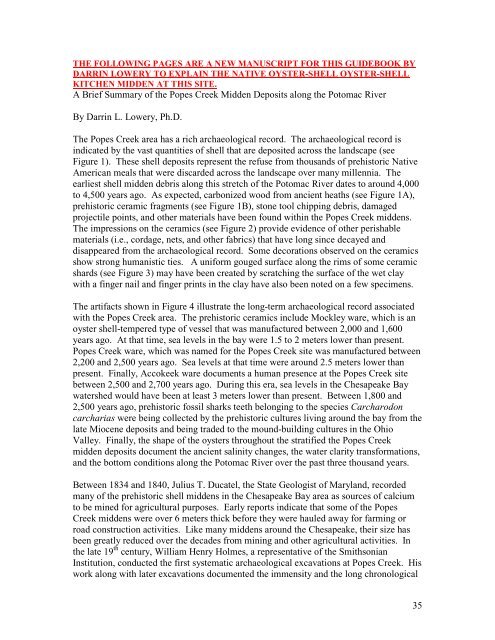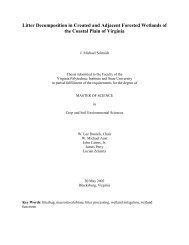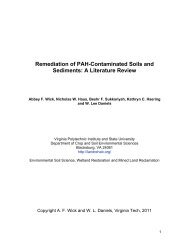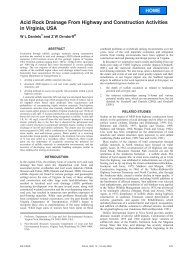ACID SULFATE SOILS - Sawgal.umd.edu - University of Maryland
ACID SULFATE SOILS - Sawgal.umd.edu - University of Maryland
ACID SULFATE SOILS - Sawgal.umd.edu - University of Maryland
Create successful ePaper yourself
Turn your PDF publications into a flip-book with our unique Google optimized e-Paper software.
THE FOLLOWING PAGES ARE A NEW MANUSCRIPT FOR THIS GUIDEBOOK BY<br />
DARRIN LOWERY TO EXPLAIN THE NATIVE OYSTER-SHELL OYSTER-SHELL<br />
KITCHEN MIDDEN AT THIS SITE.<br />
A Brief Summary <strong>of</strong> the Popes Creek Midden Deposits along the Potomac River<br />
By Darrin L. Lowery, Ph.D.<br />
The Popes Creek area has a rich archaeological record. The archaeological record is<br />
indicated by the vast quantities <strong>of</strong> shell that are deposited across the landscape (see<br />
Figure 1). These shell deposits represent the refuse from thousands <strong>of</strong> prehistoric Native<br />
American meals that were discarded across the landscape over many millennia. The<br />
earliest shell midden debris along this stretch <strong>of</strong> the Potomac River dates to around 4,000<br />
to 4,500 years ago. As expected, carbonized wood from ancient heaths (see Figure 1A),<br />
prehistoric ceramic fragments (see Figure 1B), stone tool chipping debris, damaged<br />
projectile points, and other materials have been found within the Popes Creek middens.<br />
The impressions on the ceramics (see Figure 2) provide evidence <strong>of</strong> other perishable<br />
materials (i.e., cordage, nets, and other fabrics) that have long since decayed and<br />
disappeared from the archaeological record. Some decorations observed on the ceramics<br />
show strong humanistic ties. A uniform gouged surface along the rims <strong>of</strong> some ceramic<br />
shards (see Figure 3) may have been created by scratching the surface <strong>of</strong> the wet clay<br />
with a finger nail and finger prints in the clay have also been noted on a few specimens.<br />
The artifacts shown in Figure 4 illustrate the long-term archaeological record associated<br />
with the Popes Creek area. The prehistoric ceramics include Mockley ware, which is an<br />
oyster shell-tempered type <strong>of</strong> vessel that was manufactured between 2,000 and 1,600<br />
years ago. At that time, sea levels in the bay were 1.5 to 2 meters lower than present.<br />
Popes Creek ware, which was named for the Popes Creek site was manufactured between<br />
2,200 and 2,500 years ago. Sea levels at that time were around 2.5 meters lower than<br />
present. Finally, Accokeek ware documents a human presence at the Popes Creek site<br />
between 2,500 and 2,700 years ago. During this era, sea levels in the Chesapeake Bay<br />
watershed would have been at least 3 meters lower than present. Between 1,800 and<br />
2,500 years ago, prehistoric fossil sharks teeth belonging to the species Carcharodon<br />
carcharias were being collected by the prehistoric cultures living around the bay from the<br />
late Miocene deposits and being traded to the mound-building cultures in the Ohio<br />
Valley. Finally, the shape <strong>of</strong> the oysters throughout the stratified the Popes Creek<br />
midden deposits document the ancient salinity changes, the water clarity transformations,<br />
and the bottom conditions along the Potomac River over the past three thousand years.<br />
Between 1834 and 1840, Julius T. Ducatel, the State Geologist <strong>of</strong> <strong>Maryland</strong>, recorded<br />
many <strong>of</strong> the prehistoric shell middens in the Chesapeake Bay area as sources <strong>of</strong> calcium<br />
to be mined for agricultural purposes. Early reports indicate that some <strong>of</strong> the Popes<br />
Creek middens were over 6 meters thick before they were hauled away for farming or<br />
road construction activities. Like many middens around the Chesapeake, their size has<br />
been greatly r<strong>edu</strong>ced over the decades from mining and other agricultural activities. In<br />
the late 19 th century, William Henry Holmes, a representative <strong>of</strong> the Smithsonian<br />
Institution, conducted the first systematic archaeological excavations at Popes Creek. His<br />
work along with later excavations documented the immensity and the long chronological<br />
35












